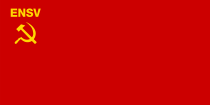 Flag of the Estonian SSR (1953–1990) | |
| Use | Historical |
|---|---|
| Proportion | 1:2 |
| Adopted | 6 February 1953 |
| Relinquished | 8 May 1990 |
| Design | A red flag with the golden hammer and sickle and outlined star above a band of blue water waves near the bottom. |
| Designed by | Paul Luhtein[1] |
 Reverse of the flag (1953–1990) | |
| Use | Reverse Flag |
| Proportion | 1:2 |
 Flag of the Estonian SSR (1940–1953) | |
| Use | Historical |
| Proportion | 1:2 |
| Adopted | 31 October 1940 |
| Relinquished | 6 February 1953 |
The flag of the Estonian Soviet Socialist Republic was officially adopted by the former Soviet Union in 1940. It showed a set of Communist symbols: a yellow hammer and sickle on a red field and, after official change of the flag's design in 1953, also an outlined yellow star, above a band of water waves near the bottom.[2]
YouTube Encyclopedic
-
1/3Views:10 23131 6601 424 983
-
Comparing Old Soviet Flags To Current National Flags Of Former Soviet Socialist Republics
-
Soviet republics and Estonia
-
How are the former Soviet countries doing today?
Transcription
History
After the Soviet invasion and occupation of Estonia in June 1940, the country was annexed to, and became an administrative subdivision of, the USSR under the name "Estonian Soviet Socialist Republic" in August 1940. After 31 October 1940, a Soviet Union flag with Latin script ENSV replacing the star above the hammer and sickle, was officially used by the Soviet authorities in the Estonian SSR. On 6 February 1953, a new version of the flag was adopted. It too followed the style of the flag of the Soviet Union, with six spiky blue and white wavy stripes added to the bottom.
During the period of foreign rule in 1940–1991, the Estonian diaspora and diplomatic service around the world continued to use the national flag of Estonia, whereas the use of the national tricolour and its blue, black and white colour combination was banned and punishable by law in the Soviet Union until 1988.[3]
On 20 October 1988, the usage of the blue-black-white flag was officially allowed again by Estonian authorities. On the evening of 23 February 1989 the Soviet flag was taken down permanently from the tower of Pikk Hermann of the Toompea Castle. It was replaced with the national blue-black-white flag on the next morning, 24 February, upon the 70th anniversary of the Estonian Declaration of Independence.
With the Act on symbols of Estonia, passed on 8 May 1990, a year before Estonia regained full independence in 1991, the use of the Estonian SSR flag and emblem as state symbols was officially discontinued.[4]
See also
- Flag of the Soviet Union
- Emblem of the Estonian SSR
- Flag of Magadan Oblast, similar design
- Flag of Estonia
- Flag of the Latvian Soviet Socialist Republic — a visually similar flag
Notes
- ^ "Paul Luhtein 22. III 1909 – 8. II 2007". Sirp (in Estonian). Retrieved 12 September 2021.
- ^ Guide to the Flags of the World by Mauro Talocci, revised and updated by Whitney Smith (ISBN 0-688-01141-1) p. 20.
- ^ "Minevikuminutid: sinimustvalge oli okupatsioonivastane sümbol". ERR (in Estonian). 21 February 2018. Retrieved 12 September 2021.
- ^ "Seadus Eesti sümboolikast – Riigi Teataja". www.riigiteataja.ee. Retrieved 12 September 2021.

